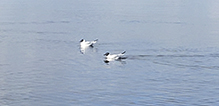Franklin’s Gull
(Leucophaeus pipixcan)
Conservation • Description • Habitat • Ecology • Distribution • Taxonomy
Conservation Status |
|||
| IUCN Red List | LC - Least Concern |
||
| NatureServe | N4B - Apparently Secure Breeding S3B - Vulnerable Breeding |
||
| Minnesota | Special Concern Species in Greatest Conservation Need |
||
Description
During breeding season the head is black with a broken white eye ring. In nonbreeding season the head is white with a dark gray patch that extends around the eyes and the back of the head. The back of the neck is white. The bill and legs are orangish-red.
The back and uppersides of the wings (mantle) is dark gray. The underparts are white. The primary wing feathers have a white band and limited black tips which appear as a black crescent on white wingtips when in flight. When at rest the wingtips appear black with large white spots. The underside of the wing white and unmarked except for the limited black wingtips and white band.
Size
Total length: 13″ to 15″
Wingspan: 36″
Voice
The long call is a nasal, laughing series of kowii kowii kowii or queel quieel queel, each note rising.
Similar Species
Bonaparte’s Gull (Chroicocephalus philadelphia) wing upperside has a conspicuous white wedge near the tip, visible when in flight. The bill is black
Laughing Gull (Larus atricilla) is larger. The legs are black. Non-breeding adults lack the dark gray patch around the eyes and head.
Habitat
Breeding: Large prairie marshes with areas of open water
Migration: Agricultural fields, pastures, landfills, marshes, shores of rivers and lakes
Ecology
Migration
Late March to mid-May and late July to late November
Nesting
Food
Grasshoppers, dragonflies, earthworms; mice; small fish; crustaceans; and sometimes seeds.
Distribution
Occurrence
Common and at times abundant migrant in the western and central counties, rare to uncommon or irregular migrant elsewhere.
Maps
The Minnesota Ornithologists’ Union All Seasons Species Occurrence Map
Taxonomy
Class
Aves (Birds)
Order
Charadriiformes (shorebirds and allies)
Family
Laridae (gulls, terns, and skimmers)
Subfamily
Larinae (gulls)
Genus
Leucophaeus (hooded gulls)
Genus
This species was formerly placed in the genus Larus. Mitochondrial DNA analysis of all gull (family Laridae) species in 2005 (Pons J.M.; Hassanin, A.; Crochet P.A. [2005]) supported rearranging the Laridae into ten species. Franklin’s Gull and four other gulls were placed in the “hooded” species genus Leucophaeus.
Subordinate Taxa
Synonyms
Larus pipixcan
Leucophaeus pipixcan pipixcan
Visitor Photos
Share your photo of this bird.
This button not working for you?
Simply email us at info@MinnesotaSeasons.com.
Attach one or more photos and, if you like, a caption.
Luciearl |
 |
Several hundred of these were in our bay this afternoon. They are not the typical Gull we see on the lake, so possibly migrating through? |
MinnesotaSeasons.com Photos
|
|

Slideshows
Franklin's Gull
Andy Reago & Chrissy McClarren
Franklin's Gull
JMC Nature Photos

Visitor Videos
Share your video of this bird.
This button not working for you?
Simply email us at info@MinnesotaSeasons.com.
Attach a video, a YouTube link, or a cloud storage link.
Other Videos
Franklin's Gull (Laridae: Larus pipixcan)
Carl Barrentine
GAVIOTA DE FRANKLIN (Leucophaeus pipixcan)
Juan Tassara
Franklin's gull. South Padre Island
tavovalero
Frankiln's Gull (Laridae: Larus pipixcan) Feeding
Carl Barrentine
FRANKLIN'S GULL at Cley NWT!
Penny Clarke

Visitor Sightings
Report a sighting of this bird.
This button not working for you?
Simply email us at info@MinnesotaSeasons.com.
Be sure to include a location.
Luciearl
5/10/2021
John Valo
5/12/2021
According to The Minnesota Ornithologists’ Union All Seasons Species Occurrence Map, Franklin’s Gull is rare or absent in Cass County except in the fall, when they are uncommon. According to Birds of Minnesota and Wisconsin (Jannssen et al., 2003), it is a common migrant through most of the state from late March to mid-May.
Luciearl
7/28/2018
Location: Gull Lake, Lake Shore, MN
I've been on Gull Lake for nearly 60 yrs. Gulls are common, so don't pay too much attention to them. I was out in our pontoon this past weekend. I pointed out a gull with a black head to my husband because I dont recall seeing one before. It was floating around near us before taking off. Happen to see the name on your web site. It's also my son's name. Do you always visit state parks? Would you visit Fritz Loven Park? Or do they have to be larger?
John Valo
8/1/2018
I sometimes visit city and county parks when they are recommended to me...
If this is one of your favorite parks, consider uploading some photos of the park (signs, facilities, lakes, trails, scenery, etc.), and I will create a page for it on MinnesotaSeasons.com.
Minnesota Seasons Sightings

